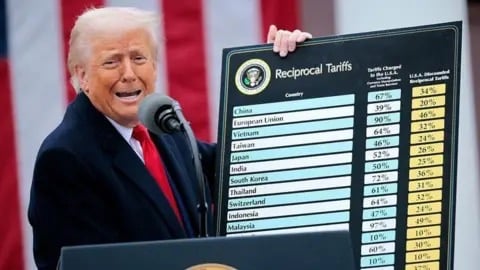Bold Moves
4/2/20254 min read


Over the past several months, global financial markets have been navigating a landscape defined by turbulence, uncertainty, and transformation. While many macroeconomic variables traditionally command the headlines, the most defining factor this year has been the return of Donald Trump and his aggressive tariff policy. From the outset, this has weighed heavily on investor sentiment, forcing many key global issues into the background. The renewed imposition of astronomical tariffs on Chinese imports rattled markets, introducing a new wave of caution that especially impacted institutional players.
While many hedge fund managers and large investment funds adopted a wait-and-see approach, a surprising resilience emerged among retail investors. This cohort saw opportunity in the downturn, using the sharp pullbacks as a chance to invest in emerging high-tech equities—companies leading the charge in AI-driven productivity and technological disruption. From the beginning, I considered these aggressive tariff strategies to be politically unsustainable. I believed that countries would eventually align with U.S. interests—not through coercion, but through pragmatic negotiations. It’s now evident that several nations have reached provisional agreements, and I anticipate that U.S.-China tariffs will be further relaxed in the near future. Likewise, I expect the U.S. will reach consensus-based trade alignments with the European Union as well.
Contrary to his often polarizing persona, Trump is revealing himself to be more market-friendly than many anticipated. These negotiations, if concluded swiftly, could bring a new wave of optimism into equity markets. Based on this outlook, I continue to maintain a bullish stance, particularly toward firms demonstrating productivity improvements and AI integration.
We used to speak of technological transformation as the future—but the future is now. Major corporations are replacing human labor with AI systems at a pace far exceeding expectations. The efficiency gains have been extraordinary. As a result, we’re witnessing a structural revaluation of what growth and profitability mean in this new age.
From a traditional valuation lens—metrics like Price-to-Earnings (P/E) ratios, price-to-sales, and enterprise multiples—today’s market may seem overpriced. But those models were built for a different era. What we are observing now is a structural re-rating of valuations, where “expensive” becomes the new normal in a demand-heavy, innovation-driven ecosystem. Retail participation in the markets is surging globally, and this influx of new capital is pushing multiples higher. It’s no longer surprising to see forward P/E ratios for disruptive tech companies in the 50–70x range, yet that doesn’t necessarily make them poor investments.
Take Nvidia as a case in point. Despite traditional valuation concerns, its dominance in AI chip design and ecosystem integration makes it more than just a semiconductor company—it’s becoming the foundational infrastructure for future intelligence. Palantir, Tesla, and others are similarly positioned. These are not just businesses; they are platforms reshaping the world. I continue to hold positions in these names, convinced that their long-term potential far outweighs short-term valuation anxieties.
One of the more sobering developments has been the waning confidence in China. Once heralded as the future of economic growth, China now faces scrutiny over opaque data reporting, manipulation of macroeconomic indicators, and a severely distressed real estate sector. Investors are increasingly skeptical, and global capital is recalibrating its exposure accordingly.
Meanwhile, in the European Union, I believe there’s an urgent need for strategic realignment. The bloc must stop reacting and start shaping its economic future. Investment in defense, tech sovereignty, and industrial competitiveness is no longer optional. Firms like ASML—already a lynchpin in the global semiconductor supply chain—should be further empowered through state-supported initiatives to counterbalance U.S. and Chinese dominance. Europe needs to foster its champions or risk becoming a technological colony.
Politically, we are witnessing a shift towards more radical right-wing parties that promise assertive reforms. This trend, particularly visible in Germany, could catalyze long-needed modernization in traditional industries. Germany, long reliant on its automotive sector, must now pivot aggressively into the AI and digital infrastructure domains to stay competitive. Google remains an underdog in this race—a sleeping giant whose data reserves are massively underutilized. If and when they unlock that potential, a powerful rerating may follow.
In Turkey, cautious optimism is taking root. Recent moves toward disciplined fiscal policy are commendable and may yield tangible results in the coming quarters. However, challenges persist. The absence of democratic reforms, continued high levels of public spending, and a deep-seated lack of institutional trust continue to hold back investor confidence. Unless these structural issues are addressed, inflation will remain stubbornly high and FDI (foreign direct investment) flows will continue to lag.
Looking ahead, I maintain a cautiously optimistic stance. While the global economy will remain volatile—especially amid political uncertainty and rapid tech-driven disruption—there are more opportunities than ever for thoughtful, risk-tolerant investors.
The key lies in selectivity. Blanket buying of the index no longer ensures alpha. Instead, investors must focus on companies that lead in innovation, productivity, and platform scalability. I expect volatility to persist, and we may very well see further sharp pullbacks. But for those who stay rational and selective, the next phase of wealth creation will be defined not just by timing, but by insight and conviction.
I personally continue to invest in companies that excite the public imagination and show concrete improvements in efficiency and market relevance. This includes Nvidia, but also newer, smaller players redefining their respective verticals. High valuations? Yes. But also high potential. And as someone with a slightly higher-than-average risk appetite, I am comfortable embracing volatility in pursuit of exponential growth.
As we enter the final quarter of 2025, the future is nearer than it appears. Investors must decide whether to cling to outdated valuation paradigms or adapt to a world where data, AI, and agility define success. The markets may be turbulent—but turbulence breeds opportunity.
